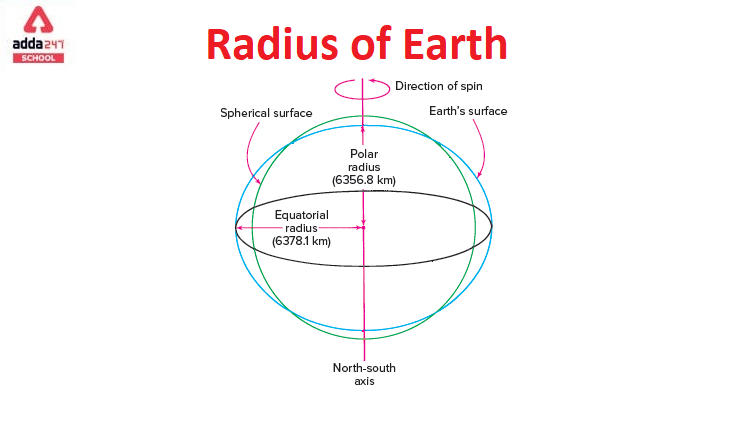Radius of Earth in KM
The symbol R? stands for the radius of Earth. The radius of our planet, The Earth, is the distance from the centre of the Earth to a point on or near its surface, and it ranges from nearly 6,378 km to nearly 6,357 km, approximating the figure of Earth by an Earth spheroid.
Furthermore, in astronomy and geophysics, a nominal radius of earth is sometimes employed as a unit of measurement.
6,371 kilometres is commonly used as a global average value.
The radius of curvature is another approach to define and measure the Earth radius, and some definitions produce results that are outside the range between polar and equatorial radius because they include local or geoidal topography. Another reason could be that they are based on abstract geometrical ideas.
Radius of Earth in Miles
The radius of the Earth in miles is approximately 3,959 miles. This value is obtained by converting the Earth’s radius from kilometers to miles. As mentioned earlier, the Earth is not a perfect sphere but an oblate spheroid, and the value provided is an average radius for the Earth.
Earth Radius in Meters
The radius of the Earth in meters is approximately 6,371,000 meters. This value is obtained by converting the Earth’s radius from kilometers to meters. Keep in mind that this value is an average radius since the Earth is not a perfect sphere but an oblate spheroid.
Earth Radius in KM
Those who have had the pleasure of jet-setting or flying around the world know that the world is a huge place, but the diameter of the Earth adds a little complexity to the equation. We’ve all wondered how huge the world is from one end to the other at some point. Furthermore, because the Earth is not perfectly spherical, it fluctuates depending on where you measure from. When measured from the poles, it has a different diameter than when measured at the equator.
Scientists have discovered that the Earth is not a perfect sphere and is instead an “oblate spheroid,” according to an area of mathematics concerned with its measurement.
At the poles, the Earth flattens out by 0.0033528. The rotational velocity of the Earth causes the planet to bulge at the equator, resulting in this flattening.
The diameter of the Earth near the equator is around 43 kilometres bigger than the diameter of the Earth from pole to pole. According to the most recent data, the Earth’s equatorial diameter is 12,756 kilometres. The earth’s polar diameter is 12713.6 kilometres.
Items positioned near the equator are about 21 km further distant from the Earth’s centre than objects placed at the poles, to put it simply. As a result, there are some aberrations in local topography where items positioned distant from the equator are closer or farther away from the Earth’s core than objects located closer to the equator.
What is the radius of the Earth?
The radius of Earth is approximately 6,371 kilometers (or about 3,959 miles). This value represents the distance from the center of the Earth to the outer boundary, which is the Earth’s surface. It is important to note that the Earth is not a perfect sphere but is an oblate spheroid, meaning it is slightly flattened at the poles and bulging at the equator due to its rotation. As a result, the equatorial radius is slightly larger than the polar radius, but the value given above is an average radius for the Earth.
Radius of Earth Orbit
The mass of the Earth can be calculated using Newton’s law of gravitation, which would be due to the total (F), which is equal to the gravitational constant multiplied by the planet’s mass and the mass of the object, divided by the square of the planet’s radius. We set this equal to the fundamental equation, force (F) equals mass (m) multiplied by acceleration (a), and since the acceleration due to gravity is 9.8 m/s2, the gravitational constant (G) is 6.673 × 10−11 Nm2/kg2, the radius of the Earth is 6.37 × 106 m, and mass cancels out, we arrive at 5.96 × 1024 kg as the answer for the mass of the Earth.
Earth is the third planet from the Sun and barely a speck in the vastness of space. It is, nevertheless, the home of humans and all other known life. Animals, plants, and other species can be found practically everywhere on Earth’s surface, despite its fifth-largest size. Its mass is estimated to be 5.98 × 1024 kg. A characteristic that is inherent in mass. It is unaffected by the object’s surroundings or the measurement method. It’s a scalar quantity, which means it’s a single value in the proper unit with no direction.
Related Post:
- Modern Periodic Table Of Elements With Name & Atomic Mass
- Barriers Of Communication: Definition, Examples, Download PDF
- Difference Between Plant Cell And Animal Cell
- Difference Between Mass And Weight
- Layers Of Atmosphere In Order, Sequence, Diagram
- Ohm’s Law: Definition, Formula, Examples
- First Law Of Thermodynamics
- Freedom Fighters Of India
- Most Popular Festivals Of India List
- Viscosity Of Water: Meaning, Formula, Unit, Examples, Symbol






 NEET City Intimation Slip 2025 Available...
NEET City Intimation Slip 2025 Available...
 WB Madhyamik Result 2025 OUT at wbresult...
WB Madhyamik Result 2025 OUT at wbresult...
 CUET UG 2025 City Intimation Slip PDF Li...
CUET UG 2025 City Intimation Slip PDF Li...










